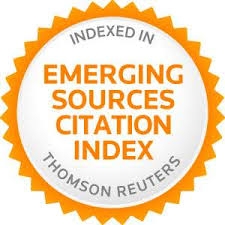Cyberbullying escolar: incidencia del teléfono móvil e internet en adolescentes
Resumen
Palabras clave
Referencias
Alvarez-García, D., Dobarro, A. & Núñez, J. C. (2015). Validez y fiabilidad del Cuestionario de cibervictimización en estudiantes de Secundaria. Aula Abierta, 43, 32-38. doi: http://dx.doi.org/10.1016/j.aula.2014.11.001
Amado, J., Matos, A., Pessoa, T y Jäger, T. (2009). Cyberbullying: um desafio à investigação e à formação. Revista Interacções, 5(13), 301-326.
Avilés, J. M. (2009). Ciberbullying. Diferencias entre el alumnado de Secundaria. Boletín de Psicología, 96, 79-96.
Baruch, Y. (2005). Bullying on the Net: Adverse behavior on email and its impact. Information and Management, 42, 361-371. doi: https://doi.org/10.1016/j.im.2004.02.001
Belsey, B. (2005). Cyberbullying: An emerging Threat to the “always on” generation. Recuperado de http://www.cyberbullying.ca
Blaszczynski, A. (2006). Internet use: In search of an addiction. International Journal of Mental Health and Addiction, 4, 7-9. doi: https://doi.org/10.1007/s11469-006-9002-3
Buelga, S., Cava, M. J., & Musitu, G. (2010). Cyberbullying: victimización entre adolescentes a través del teléfono móvil y de Internet. Psicothema, 22(4), 784-789. doi: https://doi.org/10.1590/S1020-49892012000700006
Buelga, S., Cava, M. J. & Musitu, G. (2012). Validación de la Escala de victimización entre adolescentes a través del teléfono móvil y de Internet. Revista Panamericana de Salud Publica, 32(1), 36-42.
Buelga, S., Musitu, G., Murgui, S. & Pons, J. (2008). Reputation and aggressive behavior in adolescence. The Spanish Journal of Psychology, 11(1), 192-200. doi: https://doi.org/10.1017/S1138741600004236
Burgess-Proctor, A., Patchin, J. W. & Hinduja, S. (2009). Cyberbullying and online harassment: Reconceptualizing the victimization of adolescent girls. En V. García & J. Clifford (Eds.), Female crime victims: Reality reconsidered (pp. 153-175). Upper Saddle River, NJ: Prentice Hall.
Calmaestra, J. (2011). Cyberbullying: prevalencia y características de un nuevo tipo de bullying indirecto. Córdoba: Servicio de Publicaciones Universidad de Córdoba. Tesis doctoral.
Calvete, E., Orue, I., Estévez, A., Villardón, L. & Padilla, P. (2010). Cyberbullying in adolescents: Modalities and aggressors´ profile. Computers in Human Behavior, 26(5), 1128-1135. doi: https://doi.org/10.1016/j.chb.2010.03.017
Campbell, M. A. (2005). Cyberbullying: An old problem in a new guise? Australian Journal of Guidance and Counselling, 15(1), 68-76. doi: https://doi.org/10.1375/ajgc.15.1.68
Cerezo, F. (2009). Bullying: Análisis de la situación en las aulas españolas. International Journal of Psychology and Psychological Therapy, 9(3), 383-395.
Cerezo-Ramírez, F. (2012). Psique. Bullying a través de las TIC. Boletín Científico Sapiens Research, 2(2), 24-29.
David-Ferdon, C. & Feldman, M. (2007). Electronic media, violence and adolescents: An emerging public health problem. Journal of Adolescent Health, 41(6, Supplement 1), S1-S5. doi: https://doi.org/10.1016/j.jadohealth.2007.08.020
Dehue, F., Bolman, C. & Vollink, T. (2008). Cyberbullying: Youngsters´ experiences and parental perception. CyberPsychology & Behavior, 11(2), 217-223. doi: https://doi.org/10.1089/cpb.2007.0008
Del Rey, R., Casas, J. & Ortega, R. (2012). El programa ConRed, una práctica basada en la evidencia. Comunicar, 39, 129-138. doi: http://dx.doi.org/10.3916/C39-2012-03-03
Díaz-Aguadó, M. J. (2005). La violencia entre iguales en la adolescencia y su prevención desde la escuela. Psicothema, 4(17), 549-558.
Estévez, A., Villardón, L. Calvete, E., Padilla, P. & Orue, I. (2010). Adolescentes víctimas de cyberbullying: prevalencia y características. Psicología Conductual, 18(1), 73-89.
Gairín, J., Armengol, C. & Silva, B.P. (2013). El “bullying” escolar. Consideraciones organizativas y estrategias para la intervención. Educación XXI, 16(1), 17-38. doi: http://doi.org/10.5944/educXX1.16.1.715
Garaigordobil, M. (2011). Prevalencia y consecuencias del cyberbullying: Una revisión. International Journal of Psychology and Psychosocial Therapy, 11(2), 233-254.
Garaigordobil, M. (2013). Cyberbullying. Screening de acoso entre iguales. Madrid: TEA.
Garaigordobil, M. & Aliri, J. (2013). Ciberacoso (“Cyberbullying”) en el País Vasco: diferencias de sexo en víctimas, agresores y observadores. Behavioral Psychology/Psicología Conductual, 21(3), 461-474.
Garaigordobil, M. & Oñederra, J. A. (2008). Bullying: Incidence of peer violence in the schools of the Autonomour Community of the Basque Country. International Journal of Psychology and Psychological Therapy, 8(1), 51-62.
Guarini, A., Brighi, A. & Genta, M. L. (2009). Traditional Bullying and Cyberbullying in Italian Secondary Schools. En M. L. Genta, A. Brighi & A. Guarini (Eds.), Bullying and Cyberbullying in Adolescence (pp. 77-95). Roma: Carocci.
Juvonen, J. & Gross, E. F. (2008). Extending the school grounds? – Bullying experiences in Cyberspace. Journal of School Health, 78 (9), 496-505. doi: https://doi.org/10.1111/j.1746-1561.2008.00335.x
Li, Q. (2007). Bullying in the New Playground: Research into Cyberbullying and Cyber Victimisation. Australasian Journal of Educational Technology, 23(4), 435-454. doi: https://doi.org/10.14742/ajet.1245
Livingstone, S., Haddon, L., Görzig, A. & Ólafsson, K. (2011). Risks and safety on the internet: The perspective of European children. Full Findings. LSE, London: EU Kids Online.
McKenna, P. (2007). The rise of cyberbullying. The New Scientist, 195 (2613), 26-27. doi: https://doi.org/10.1016/S0262-4079(07)61835-1
Mora-Merchán, J. A. (2008). Cyberbullying: un nuevo reto para la convivencia en nuestras escuelas. Informació Psicològica, 94, 60-70.
Nocentini, A., Calmaestra, J., Schultze-Krumbholz, A., Scheithauer, H., Ortega, R. & Menesini, E. (2010). Cyberbullying: Labels, behaviours and definition in three European countries. Australian Journal of Guidance and Counselling, 20(2), 129-142. doi: https://doi.org/10.1375/ajgc.20.2.129
Ortega, R., Calmaestra, J. & Mora-Merchán, J. A. (2008). Cyberbullying. International Journal of Psychology and Psychological Therapy, 8(2), 183-192.
Pelfrey., W. Jr & Weber, N. (2013). Keyboard gangsters: analysis of incidence and correlates of cyberbullying in a large urban student population. Deviant Behavior, 34, 68-84. doi: https://doi.org/10.1080/01639625.2012.707541
Perren, S., Dooley, J. J., Shaw, T & Cross, D. (2010). Bullying in school and cyberspace: Associations with depressive symptoms in Swiss and Australian adolescents. Child and Adolescent Psychiatry and Mental Health, 4(28), 1-10. doi: https://doi.org/10.1186/1753-2000-4-28
Ruiz, R., Riuró, M. & Tesouro, M. (2015). Estudio de bullying en el ciclo superior de primaria. Educación XXI, 18(1), 345-368. doi: http://doi.org/10.5944/educXX1.18.1.12384
Sánchez-Lacasa, C. & Cerezo, F. (2010). Variables personales y sociales relacionadas con la dinámica bullying en escolares de Educación Primaria. Electronic Journal of Research in Educational Psychology, 8(3), 1015-1032.
Smith, P. K., Mahdavi, J., Carvalho, C., Fisher, S., Russell, S. & Tippett, N. (2008). Cyberbullying: Its nature and impact in secondary school pupils. Journal of Child Psychology and Psychiatry, 49, 376-385. doi: https://doi.org/10.1111/j.1469-7610.2007.01846.x
Smith, P. K., Mahdavi, J., Carvalho, M. & Tippett, N. (2006). An investigation into cyberbullying, its forms, awareness and impact, and the relationship between age and gender in Cyberbullying. (Research Brief No. Brief No: RBX03-06): Anti-Bullying Alliance.
Viñas, F. (2009). Uso autoinformado de Internet en adolescents: perfil psicológico de un uso elevado de la red. International Journal of Psychology and Psychological Therapy, 9, 109-122.
Wade, A. & Beran, T. (2011). Cyberbullying: the new era of bullying. Canadian Journal of School Psychology, 26, 44-61. doi: https://doi.org/10.1177/0829573510396318
Willard, N. E. (2006). Cyberbullying and Cyberthreats: Responding to the challenge of online social cruelty, threats and distress. Eugene, Oregon: Center for Safe and Responsible Internet Use.
Willard, N. E. (2007). The authority and responsibility of school officials in responding to cyberbullying. Journal of Adolescent Health, 41(6, Supplement 1), S64-S65. doi: https://doi.org/10.1016/j.jadohealth.2007.08.013
Wright, V. H., Burnham, J. J., Inman, C. T. & Ogorchock, H. N. (2009). Cyberbullying: Using Virtual Scenarios to Educate and Raise Awareness. Journal of Computing in Teacher Education, 26(1), 35-42.
Yilmaz, H. (2011). Cyberbullying in Turkish middle schools: an exploratory study. School Psychology International, 32, 645-654. doi: https://doi.org/10.1177/0143034311410262
Enlaces refback
- No hay ningún enlace refback.


